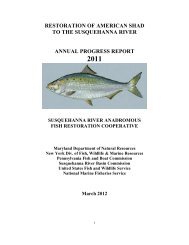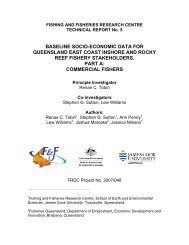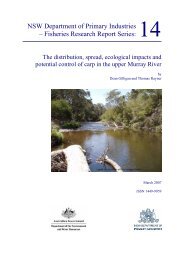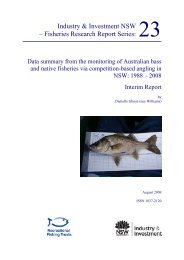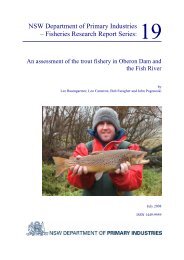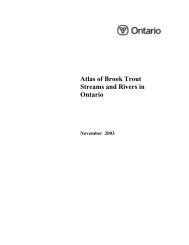Assessment of shark sighting rates by aerial ... - Fisheries Reports
Assessment of shark sighting rates by aerial ... - Fisheries Reports
Assessment of shark sighting rates by aerial ... - Fisheries Reports
Create successful ePaper yourself
Turn your PDF publications into a flip-book with our unique Google optimized e-Paper software.
NSW DPI 13<br />
3. RESULTS<br />
3.1. Depth experiment<br />
Depth trials were conducted between 0800 hr and 1600 hr over two days, encompassing an equal<br />
proportion <strong>of</strong> sunny and overcast conditions. The order <strong>of</strong> aircraft participation alternated between<br />
the two days, with equal replicates conducted each day. Water clarity as measured <strong>by</strong> secchi disk<br />
fadeout was good, with turbidities <strong>of</strong> 2.9 – 3.5 m (day 1) and 4.5 – 6.1 m (day 2). Wind strength<br />
was under 10 kts each day.<br />
No significant differences were found between aircraft types, indicating that observers in each<br />
aircraft had comparable ability to sight the <strong>shark</strong> analogues (Table 1). The maximum depth at<br />
which the 2.5 m-long analogues were observed was shallow, averaging 2.5 + 0.1 m (SE) for the<br />
fixed-wing aircraft, and 2.7 + 0.1 m (SE) for the helicopter (Fig. 4). The maximum depth <strong>of</strong> any<br />
individual <strong>sighting</strong> was 4.3 m (fixed-wing) and 3.7 m (helicopter). Although the deeper water at the<br />
12 m stations created a darker background, this had no significant effect on analogue <strong>sighting</strong><br />
depths (Table 1, Fig. 4). Observers therefore appeared to be <strong>sighting</strong> the analogues based on their<br />
appearance below the water surface, rather than through secondary effects such as shadows cast<br />
onto the substratum, or increased silhouetting <strong>of</strong> the analogues in shallower depths. The lack <strong>of</strong><br />
effect <strong>of</strong> water depth on analogue sightability allowed the subsequent distance trial to be<br />
undertaken across the width <strong>of</strong> northern Jervis Bay, including varying (9 – 15 m) substratum<br />
depths.<br />
Changes in the head shape <strong>of</strong> analogues also had no significant effect on their sightability (Table 1,<br />
Fig. 4). The increased surface area visible on the hammerhead analogues did not increase their<br />
<strong>sighting</strong> depth, nor did the decreased surface pr<strong>of</strong>ile <strong>of</strong> the white <strong>shark</strong> make them more difficult to<br />
detect. Equal vertical detection probabilities enabled deployment <strong>of</strong> all three analogue types in the<br />
subsequent distance trial.<br />
<strong>Assessment</strong> <strong>of</strong> <strong>shark</strong> <strong>sighting</strong> <strong>rates</strong> <strong>by</strong> <strong>aerial</strong> beach patrols Robbins et al.




